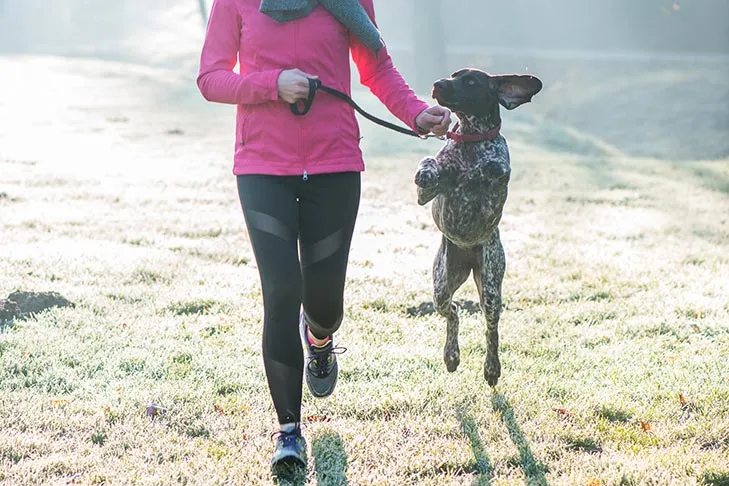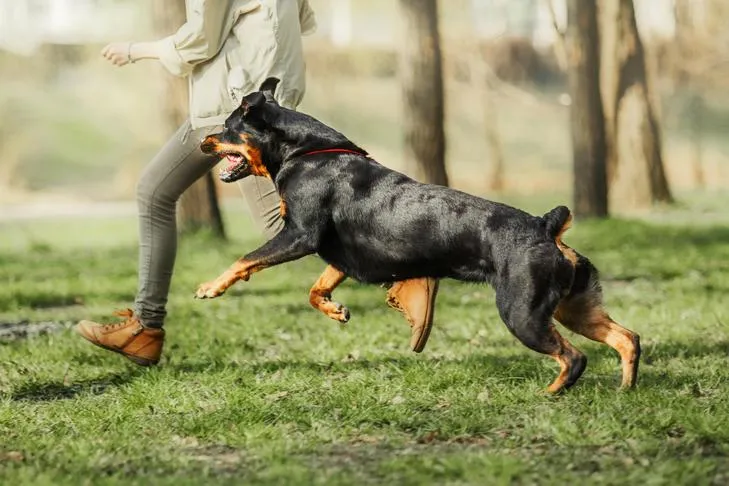Jogging with your dog is a fantastic way to bond, enjoy the outdoors, and keep both of you physically fit. Canine fitness is a crucial aspect of a dog’s overall health, and having a reliable running partner can be a significant motivator for your own exercise routine. If you’re wondering how to teach your dog to jog with you, this comprehensive guide will walk you through the essential steps, from preparing your pup to maintaining their conditioning, ensuring a safe and enjoyable experience for both of you.
Understanding Your Dog’s Readiness for Running
Before embarking on a training program to teach your dog to jog with you, it’s vital to assess if your dog is physically suited for running. Not all breeds or individual dogs are cut out for long-distance running, and age plays a crucial role. Generally, it’s not safe for puppies to engage in strenuous running, as their bones are still developing. For most breeds, veterinarians recommend waiting until your dog is about 1.5 years old before introducing them to regular jogging.
Beyond age, consider your dog’s temperament and breed characteristics. Some breeds are natural runners, while others are better suited for shorter, less intense activities. Even within a breed, individual personalities vary, with some dogs embracing running more enthusiastically than others. It is highly recommended to consult your veterinarian for a thorough physical checkup to ensure that jogging is a safe and appropriate activity for your specific dog.
 German Shorthaired Pointer running with a woman in the early morning.
German Shorthaired Pointer running with a woman in the early morning.
Mastering Loose-Leash Walking First
A foundational step in how to teach a dog to run with you is to ensure they have perfected loose-leash walking. A dog that constantly pulls on the leash is merely frustrating at a walking pace but can become genuinely dangerous when you increase your speed to a jog. The outdoor environment is full of distractions and enticing rewards like squirrels, other dogs, and interesting scents. To encourage your dog to stay by your side with a slack leash (forming a ‘J’ shape), you must be an equally rewarding presence. Utilize high-value treats, favorite toys, and plenty of verbal praise to positively reinforce your dog whenever the leash remains loose.
Consistency in your dog’s position is paramount when you begin jogging together. If your dog runs in front of you, weaves from side to side, or lags behind, they could trip you or tangle your legs in the leash, leading to falls and potential injuries for both of you. It doesn’t matter whether you choose the left or right side, but select one and stick with it consistently during training. Begin practicing at a walking pace, keeping reward placement in mind. Always deliver treats and praise when your dog is in the desired position – for instance, if you want them on your left, only offer rewards at your left leg. Once they have mastered staying on one side, you can introduce a different cue to train them for the other side if desired. Many runners also find a hands-free dog leash beneficial for jogging, allowing for a more natural running form.
Introducing Speed Cues
Once your dog is reliably walking politely at your side, you can begin to increase the pace. It’s helpful to have distinct verbal cues for different speeds. For regular walks, a command like “let’s go” can signal to your dog that it’s time to move forward. For jogging, introduce a new, clear cue such as “get running” or “move it.” The more precise information you provide your dog about your expectations, the better they will be at responding appropriately and enthusiastically.
To teach the running cue effectively, incorporate short bursts of jogging into your usual walking routine. As you transition from walking to jogging, give the new cue immediately before you accelerate. Reward your dog generously with treats and praise as soon as they hurry to catch up and match your faster pace. In the same manner, you can teach a cue like “whoa” to signal your dog to slow down or stop, which is crucial for safety and control, especially when approaching intersections or other people.
 Rottweiler running in the park playing with its owner.
Rottweiler running in the park playing with its owner.
Building Endurance Gradually
With your dog now understanding how to stay by your side and match your speed, the next step in how to train puppy to run with you (once they are old enough) is to gradually build their endurance and get them in shape. Just like humans, dogs need to develop strength and stamina slowly and progressively to avoid injury and burnout. Start by integrating small, short stretches of running into your regular walks. Over several weeks, on each subsequent outing, gradually increase the duration and distance of your running segments while decreasing the time spent walking. This measured approach allows your dog’s muscles, joints, and cardiovascular system to adapt safely to the demands of jogging long distances. Rushing this phase can lead to injuries or make your dog dislike running.
Essential Tips for a Safe and Enjoyable Jog
Even after your dog is fully trained and conditioned to be your jogging companion, it’s important to keep several safety and enjoyment tips in mind. These precautions ensure both you and your dog have a positive and healthy experience on every run.
- Warm-up and Cool-down: Always begin your runs with a brisk walk for several minutes to warm up your dog’s muscles, and end with a similar cool-down period.
- Monitor Weather Conditions: Dogs are more susceptible to heatstroke and paw pad injuries in extreme weather than humans. Be especially cautious in hot, humid conditions or on scorching pavement. In winter, protect their paws from ice, salt, and cold.
- Stay Hydrated: Always carry water for both yourself and your dog, offering it regularly throughout your run, especially on longer routes or warmer days.
- Frequent Breaks: Allow your dog frequent breaks to recharge, relieve themselves, and simply enjoy their surroundings. These short pauses can prevent fatigue and boredom.
- Off-Leash Safety: Only permit your dog to run off-leash in areas where it is safe, legal, and if they possess a highly reliable recall command amidst various distractions.
- Watch for Warning Signs: Pay close attention to your dog for any signs of fatigue or discomfort, such as excessive panting, lagging behind, limping, or reluctance to continue. Dogs often try to please their owners, even when they are tired or in pain, so it’s your responsibility to monitor them closely and end the run if needed.
 Beagle on leash running with a woman on a trail.
Beagle on leash running with a woman on a trail.
Maintaining Fitness in Extreme Weather
Dedicated joggers may brave various weather conditions, but sometimes it’s simply too cold, hot, or wet for your dog to safely join you outdoors. During such times, you can still maintain your dog’s physical conditioning with indoor exercise. Depending on your dog’s size and energy level, a spirited game of fetch in a long hallway or quick dashes up and down a carpeted flight of stairs can get their heart pumping and work their muscles. You can also set up a simple obstacle course using household items like hula hoops, cardboard boxes, or cushions, encouraging them to run and jump safely. Many training facilities also offer indoor agility classes, which provide an excellent opportunity for your dog to run, jump, and problem-solve in a controlled environment.
Furthermore, many dogs can be trained to use a treadmill. While some treadmills are specifically designed for dogs, a human treadmill can also work, provided the ramp length is sufficient for your dog’s size. Larger dogs will naturally require a longer and wider running surface. Although treadmill training is a convenient way to provide an indoor workout, it requires careful introduction. Research treadmill training protocols or consult with a professional dog trainer to ensure your dog learns to enjoy and use the machine safely. Crucially, never tie your dog to the treadmill or leave them unsupervised while it is in operation, as this can lead to serious injury.
With patience, consistent training, and a focus on safety, you and your canine companion can enjoy many miles of healthy and happy jogging together.
